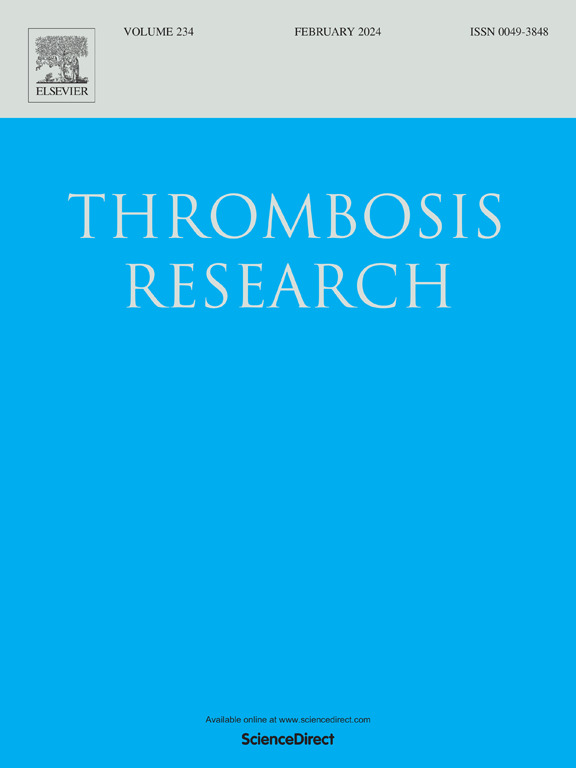一种新的可计算表型来识别儿童肺栓塞:蜈蚣研究
IF 3.4
3区 医学
Q1 HEMATOLOGY
引用次数: 0
摘要
背景:小儿肺栓塞(PE)是罕见的,需要多中心研究才能产生有意义的结果并改善护理。PEDSnet是一个包括10个儿科机构在内的多中心学习卫生系统,是研究罕见病的宝贵工具。目的建立一种可计算表型(CP)来准确识别PEDSnet中的儿童PE。方法我们在PEDSnet中开发了一种识别费城儿童医院儿童PE数据的算法,并将其与盲法图表回顾进行比较。我们确定了2012年1月1日至2022年12月31日期间的一组患者,根据CP预测他们患有PE,而同样数量的患者预测没有PE。手动图表审查确定真阳性和阴性和假阳性和阴性PE。随后进行调整以提高CP性能。在确诊PE的患者中,我们确定了PEDSnet中的一些结果,并将它们与图表回顾进行比较,以评估PEDSnet中评估结果的能力。结果152例PE患者经最佳CP鉴定为:1)住院或急诊科就诊的抗凝药物处方、配药或给药;2)急诊就诊的PE的SNOMED-CT编码;3)就诊的胸部CT或灌注检查。CP表现特征:敏感性96%,特异性88%,阳性预测值90%,阴性预测值95%。初步结果验证强调了在识别输血和溶栓方面需要改进的领域。我们报道了首例儿科PE CP,未来的研究将包括多中心CP验证和改进干预措施和结果的识别。本文章由计算机程序翻译,如有差异,请以英文原文为准。
A novel Computable phENotype To Identify Pulmonary Embolism in chilDrEn: The CENTIPEDE Study
Background
Pediatric pulmonary embolism (PE) is rare and requires multicenter research to generate meaningful results and improve care. PEDSnet is a multicenter learning health system including 10 pediatric institutions and a valuable tool to study rare diseases.
Objectives
We aimed to develop a computable phenotype (CP) to accurately identify pediatric PE in PEDSnet.
Methods
We developed an algorithm for identification of pediatric PE in Children's Hospital of Philadelphia data within PEDSnet and compared it to blinded chart review. We identified a cohort of patients from 1/1/2012–12/31/2022 who were predicted to have PE based on the CP and an equal number predicted to not have a PE. Manual chart review identified true positive and negative and false positive and negative PE. Subsequent adjustments were made to improve CP performance. In patients with a confirmed PE, we identified select outcomes in PEDSnet and compared them to chart review to evaluate the ability to assess outcomes in PEDSnet.
Results
There were 152 PE patients identified by the best performing CP which included: 1) Anticoagulant prescribed, dispensed, or administered in an inpatient or emergency department encounter, 2) SNOMED-CT code for PE, 3) Chest CT or perfusion study in the encounter. CP performance characteristics were as follows: sensitivity 96 %, specificity 88 %, positive predictive value 90 %, and negative predictive value 95 %. Preliminary outcome validation highlighted areas for improvement in identifying transfusions and thrombolysis.
Conclusions
We report the first pediatric PE CP. Future research will include multicenter CP validation and improved identification of interventions and outcomes.
求助全文
通过发布文献求助,成功后即可免费获取论文全文。
去求助
来源期刊

Thrombosis research
医学-外周血管病
CiteScore
14.60
自引率
4.00%
发文量
364
审稿时长
31 days
期刊介绍:
Thrombosis Research is an international journal dedicated to the swift dissemination of new information on thrombosis, hemostasis, and vascular biology, aimed at advancing both science and clinical care. The journal publishes peer-reviewed original research, reviews, editorials, opinions, and critiques, covering both basic and clinical studies. Priority is given to research that promises novel approaches in the diagnosis, therapy, prognosis, and prevention of thrombotic and hemorrhagic diseases.
 求助内容:
求助内容: 应助结果提醒方式:
应助结果提醒方式:


